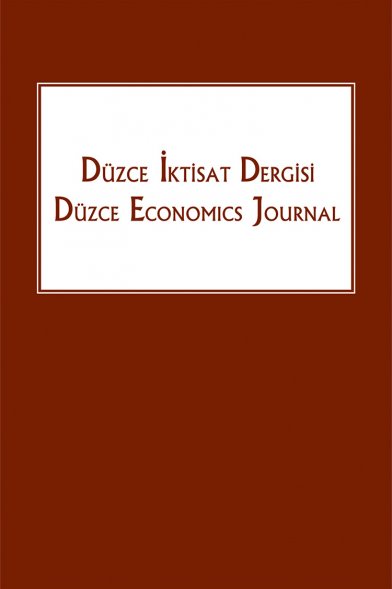COVID-19 Salgını İle Mücadelede Davranışsal İktisadın Rolü
Davranışsal İktisat, Dürtme, Kamu Politikası, COVID-19
The Role of Behavioral Economics in the Fight against COVID-19 Outbreak
Behavioral Economics, Nudge, Public Policy, COVID-19,
___
Akesson, J., Ashworth-Hayes, S., Hahn, R., Metcalfe, R. D. & Rasooly, I. (2020). Fatalism, Beliefs, and Behaviors During the COVID-19 Pandemic (No. w27245). National Bureau of Economic Research. doi: 10.3386/w27245.
Baddeley, M. (2015). Herding, social influences and behavioural bias in scientific research: Simple awareness of the hidden pressures and beliefs that influence our thinking can help to preserve objectivity. EMBO reports, 16(8), 902-905. https://.doi.org/10.15252/embr.201540637.
Berger, M. (2020). The Washington Post. Erişim linki: https://www.washingtonpost.com/world/2020/10/02/coronavirus-pandemic-demonstrations-protest-restrictions/, 03/10/2020.
Bovens, L. (2009). The ethics of nudge. In Preference change (pp. 207-219). Springer, Dordrecht.
Cherry, K. (2020). Bandwagon effect as a cognitive bias. Verywellmind, Erişim linki: https://www.verywellmind.com/what-is-the-bandwagon-effect-2795895, (Erişim tarihi: 20/08/2020).
Cherubini, P., Mazzocco, K. & Rumiati, R. (2003). Rethinking the focusing effect in decision-making. Acta psychologica, 113(1), 67-81. https://doi.org/10.1016/S0001-6918(02)00155-5.
Cosmides, L. & Tooby, J. (1994). Better than rational: Evolutionary psychology and the invisible hand. The American Economic Review, 84(2), 327-332.
Della Vigna, S. & Malmendier, U. (2006). Paying not to go to the gym. American Economic Review, 96(3), 694-719. doi: 10.1257/aer.96.3.694.
Elster, J. (1989). Social norms and economic theory. Journal of economic perspectives, 3(4), 99-117. https://.doi.org/10.1006/obhd.1998.2781.
Gilovich, T., Griffin, D. & Kahneman, D. (Eds.). (2002). Heuristics and biases: The psychology of intuitive judgment. Cambridge university press.
Giné, X., Karlan, D. & Zinman, J. (2010). Put your money where your butt is: a commitment contract for smoking cessation. American Economic Journal: Applied Economics, 2(4), 213-35. http://doi.org/10.1257/app.2.4.213.
Gupta, N. & Shaw, J. D. (1998). Let the evidence speak: financial incentives are effective!!. Compensation & Benefits Review, 30(2), 26-32. https://.doi.org/10.1177/088636879803000205.
Guthrie, J., Mancino, L. & Lin, C. T. J. (2015). Nudging consumers toward better food choices: Policy approaches to changing food consumption behaviors. Psychology & Marketing, 32(5), 501-511. https://doi.org/10.1002/mar.20795.
Haselton, M. G., Nettle, D. & Andrews, P. W. (2005). The handbook of evolutionary psychology. In Buss DM (Ed.) The evolution of cognitive bias, US: John Wiley & Sons Inc. 724-746.
Hussam, R., Rabbani, A., Reggiani, G. & Rigol, N. (2017). Habit formation and rational addiction: A field experiment in handwashing. Harvard Business School BGIE Unit Working Paper, (18-030).
Kahneman, D. & Tversky, A. (1996). On the reality of cognitive illusions. Psychological Review, 103(3), 582-591. https://doi.org/10.1037/0033-295X.103.3.582.
Kahneman, D., Knetsch, J. L. & Thaler, R. H. (1991). Anomalies: The endowment effect, loss aversion, and status quo bias. Journal of Economic perspectives, 5(1), 193-206. doi: 10.1257/jep.5.1.193.
Kahneman, D., Slovic, P. & Tversky, A. (Eds.). (1982). Judgment under uncertainty: Heuristics and biases. Cambridge university press.
Karlan, D., McConnell, M., Mullainathan, S. & Zinman, J. (2016). Getting to the top of mind: How reminders increase saving. Management Science, 62(12), 3393-3411. https://.doi.org/10.1287/mnsc.2015.2296.
Knoll, M. A. (2010). The role of behavioral economics and behavioral decision making in Americans' retirement savings decisions. Social Security Bulletin. 70 (4), 1-23.
Kühberger, A. (1998). The influence of framing on risky decisions: A meta-analysis. Organizational behavior and human decision processes, 75(1), 23-55. https://doi.org/10.1006/obhd.1998.2781.
Lea, S. E. & Webley, P. (2006). Money as tool, money as drug: The biological psychology of a strong incentive. Behavioral and Brain Sciences, (2006) 29, 161-209.
Maciejewski, M. L., Farley, J. F., Parker, J. & Wansink, D. (2010). Copayment reductions generate greater medication adherence in targeted patients. Health affairs, 29(11), 2002-2008. http://doi.org/10.1377/hlthaff.2010.0571.
Pinto, D., Ibarrarán, P., Stampini, M., Carman, K. G., Guanais, F. C., Luoto, J., Sanchez, M. & Cali, J. (2014). Applying behavioral tools to the design of health projects. Inter-American Development Bank Policy Brief, No. IDB-PB-228.
Puri, M. & Robinson, D. T. (2007). Optimism and economic choice. Journal of financial economics, 86(1), 71-99. doi:10.1016/j.jfineco.2006.09.003
Rogers, T., Milkman, K. L. & Volpp, K. G. (2014). Commitment devices: using initiatives to change behavior. JaMa, 311(20), 2065-2066. doi:10.1001/jama.2014.3485.
Samuelson, W. & Zeckhauser, R. (1988). Status quo bias in decision making. Journal of risk and uncertainty, 1(1), 7-59.
Soofi, M., Najafi, F. & Karami-Matin, B. (2020). Using Insights from Behavioral Economics to Mitigate the Spread of COVID-19. Applied Health Economics and Health Policy, 1-6. https://doi.org/10.1007/s40258-020-00595-4.
Sunstein, C. R. (2014). Nudging: a very short guide. Journal of Consumer Policy, 37(4), 583-588. DOI 10.1007/s10603-014-9273-1.
Thaler, R. H. & Benartzi, S. (2004). Save more tomorrow: Using behavioral economics to increase employee saving. Journal of political Economy, 112(S1), 164-187.
Thaler, R. H. & Shefrin, H. M. (1981). An economic theory of self-control. Journal of political Economy, 89(2), 392-406.
Thaler, R. H. (2016). Behavioral economics: Past, present, and future. American Economic Review, 106(7), 1577-1600. doi: 10.1257/aer.106.7.1577.
Thaler, R. H. & Sunstein, C. R. (2003). Libertarian paternalism. American economic review, 93(2), 175-179. doi: 10.1257/000282803321947001.
Thaler, R.H. & Sunstein, C.R. (2008). Nudge: Improving decisions about health, wealth and happiness. London: Yale University Press.
Wansink, B. (2007). Mindless eating: Why we eat more than we think. Bantam.
Wilder-Smith, A. & Freedman, D. O. (2020). Isolation, quarantine, social distancing and community containment: pivotal role for old-style public health measures in the novel coronavirus (2019-nCoV) outbreak. Journal of travel medicine, 2020, 1-4. doi: 10.1093/jtm/taaa020.
- ISSN: 2757-6558
- Yayın Aralığı: Yılda 2 Sayı
- Başlangıç: 2020
- Yayıncı: Şerif CANBAY
COVID-19 Salgını İle Mücadelede Davranışsal İktisadın Rolü
Mehmet Emin YARDIMCI, Erkan OFLAZ, Oktay MENECLER
İaşe Temelli Ekonomik Model: Osmanlı Örneği
Mehmet BATMAN, Sema YILMAZ GENÇ
Katılım Bankası Çalışanlarının İslami Finans Hassasiyeti Üzerine Bir Araştırma
Cemil BALKANLI, Fatih YARDIMCIOĞLU
